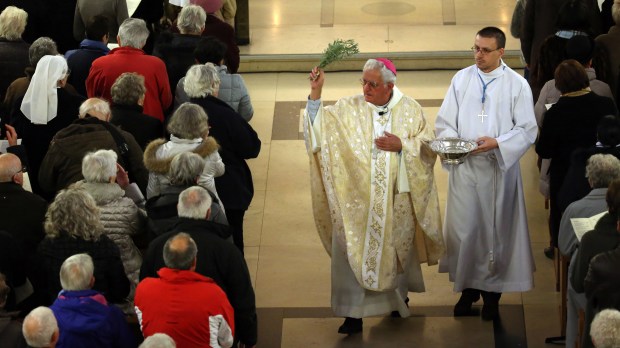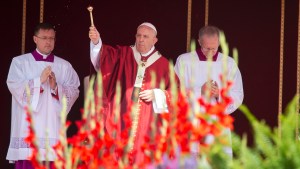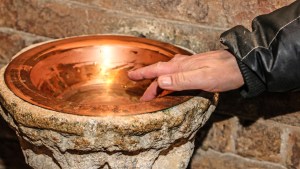During the Easter season, as well as during other times of the year, the priest will often walk down the central aisle to bless the people with holy water. Many priests will use a leafy branch, or what looks like a bunch of straw, to sprinkle the water.
While it may seem like a practical choice, it is an option that has deep biblical symbolism.
First of all, this sprinkling rite is meant to recall our baptism, as the priest explains during the blessing of holy water.
Dear brethren (brothers and sisters), let us humbly beseech the lord our God to bless this water he has created, which will be sprinkled on us as a memorial of our Baptism. may he help us by his grace to remain faithful to the spirit we have received.
Secondly, the choice of a leafy branch or bunch of straw is meant to recall Psalm 51.
Cleanse me with hyssop, that I may be pure; wash me, and I will be whiter than snow.
Psalm 51:9
This Psalm is often sung during the sprinkling rite and asks God to cleanse us, making our souls “white as snow.”
Furthermore, hyssop is also mentioned in the book of Exodus and further compounds this symbolism.
Moses summoned all the elders of Israel and said to them, “Go and procure lambs for your families, and slaughter the Passover victims. Then take a bunch of hyssop, and dipping it in the blood that is in the basin, apply some of this blood to the lintel and the two doorposts. And none of you shall go outdoors until morning. For when the Lord goes by to strike down the Egyptians, seeing the blood on the lintel and the two doorposts, the Lord will pass over that door and not let the destroyer come into your houses to strike you down.
Exodus 12:21-23
The symbolism is clear, as Jesus is the “Lamb of God” and it is through his blood that we are cleansed in the waters of baptism.
The priest is then recalling that hyssop of Exodus and the blood of the lamb that is now sprinkled upon us, to cleanse us of our sins.
Furthermore, the book of Numbers proscribes a sprinkling with water and hyssop to cleanse the unclean.
For anyone who is thus unclean, ashes shall be taken from the burnt purification offering, and spring water will be poured on them from a vessel. Then someone who is clean will take hyssop, dip it in this water, and sprinkle it on the tent and on all the vessels and persons that were in it, or on the one who touched the bone, the slain person or the other corpse, or the grave. The clean will sprinkle the unclean on the third and on the seventh day, and thus purify them on the seventh day.
Numbers 19:17-19
The next time you see a priest using a leafy branch to sprinkle the congregation, recognize the beautiful symbolism of this action and let God’s grace flood into your heart.



